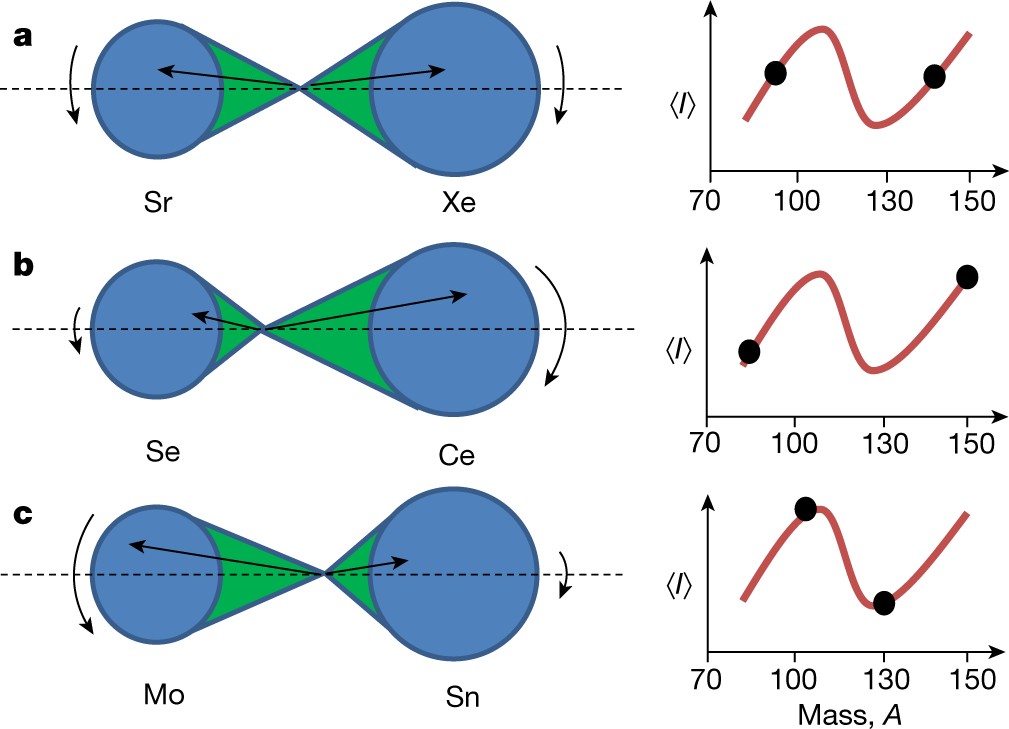J. N. Wilson, D. Thisse, ... , P.-A. Soderstrom, C. Surder, G. Tocabens, V. Vedia, D. Verney, N. Warr, B. Wasilewska, J. Wiederhold, M. Yavahchova, F. Zeiser, S. Ziliani
Nuclear physicists at the ELI-NP have contributed to an international research collaboration to determine how the spin of the two fragments, resulting from the splitting of an atomic nucleus, is generated and published their findings in Nature [DOI: https://doi.org/10.1038/s41586-021-03304-w].
Nuclear fission, in which a heavy nucleus splits in two and releases energy, was discovered at the end of the 1930s by the chemists Otto Hahn, who was rewarded with the Nobel Prize in Chemistry in 1944, Fritz Strassmann, and the physicists Lise Meitner and Otto Frisch. Despite the process being known for a long time, one of the open questions about the process remaining to this day is why, when a heavy atomic nucleus fissions, the resulting fragments are observed to emerge spinning, even when the original nucleus did not spin at all. There are many competing theories, but the majority state that the spin of the fission fragments is generated before the nucleus splits, leading to a clear correlation of the spins of the two partner fragments.
A group including researchers from 37 institutes and 16 countries - among them scientists from ELI-NP/IFIN-HH - led by the Irene-Joliot-Curie Laboratory in Orsay has performed a series of experiments at the ALTO accelerator facility in Orsay, France, and have revealed that the fragments resulting from nuclear fission obtain their intrinsic angular momentum (or spin) after fission, not before, as previously widely assumed. This result was made possible by the 'nu-Ball' collaboration, an international group of nuclear physicists aiming to study a wide range of nuclei and their structure.
To reveal the mechanism generating fragment spin, the team induced nuclear fission reactions at the ALTO facility and measured gamma rays, which are emitted in the process. Specifically, from the uranium isotope 238U and the thorium isotope 232Th with a pulsed neutron beam, and 252Cf from spontaneous fission. The experiments were performed from February until June 2018 with more than 1200 hours of beamtime. From ELI-NP, Dr. Par-Anders Soderstrom contributed to the preparation of the experiment, participated in the measurements, and the scientific discussion.
The main author of the study, Dr Jonathan Wilson from the IJC Laboratory in Orsay, said: "What really surprised me was the lack of significant dependence of the average spin observed in one fragment on the minimum spin demanded in the partner fragment. Most theories hypothesizing that spin is generated before fission would have predicted a strong correlation. Our results show that the fragment spin emerges after the splitting. It can be illustrated with by the snapping of a stretched elastic band which results in a turning force, or torque."
For ELI-NP as a facility, these new results can break new grounds in our understanding of one of the fundamental properties of nuclear fission. With the combination of the high-intensity gamma beam VEGA currently under construction, and the state-of-the-art segmented high-resolution gamma spectrometer ELIADE already present at the ELI-NP laboratory, scientists from Romania and the world will have the possibility to explore a range of rare fissioning isotopes not possible anywhere else in the world. This will provide possibilities and challenges for both experimentalists and theorists to understand the nuclear fission process, in the new light that these findings shine.
Links



